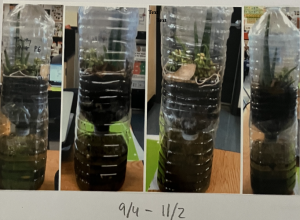Chloe Y. (6th Grade ) Timothy Y. (8th Grade)
Everyone knows that Artificial intelligence (AI)
is changing the way someone lives and works, from helping doctors diagnose diseases to making our smartphones smarter. However, as everyone embraces this amazing technology, it’s important to think about how they affect our planet. There are four main areas where AI has an impact on the environment: energy consumption, manufacturing footprint, electronic waste (e-waste), and resource depletion. Today, let’s explore each of these in more detail.
First, training large AI models requires a significant amount of energy.
Think of it like a strenuous workout for a computer—it has to process vast amounts of data, which demands substantial computational power. This power typically comes from large data centers that operate continuously, and many of these facilities rely on electricity from fossil fuels such as coal and natural gas. Unfortunately, these energy sources emit greenhouse gasses, which are detrimental to the environment and contribute to climate change. Imagine if all the energy used by these computers came from renewable sources like wind or solar power; this could significantly reduce the negative impact of AI on our planet. Tech companies must seek ways to use cleaner energy so that the benefits of AI do not come at the expense of our environment.
Second, before someone can use AI devices like smartphones or computers,
these devices must be manufactured. The manufacturing process involves extracting raw materials from the Earth, which can have harmful effects. For instance, mining for metals can destroy habitats and pollute water sources. Additionally, the factories that produce these devices can contribute to air pollution and generate waste. Transportation also plays a significant role; shipping these products from factories to stores consumes energy and creates emissions. As a result, the environmental impact of AI begins long before someone purchases a device. It’s essential to consider how we can produce these products in a more environmentally friendly manner.
Next, technology can help produce lots of electronic-waste(e-waste).
As technology advances quickly, people often replace their old devices with new ones. This leads to a growing problem called e-waste. E-waste includes old computers, phones, and other electronic gadgets that no one uses. Many of these devices contain harmful materials that can hurt the environment if they are thrown away without properly being disposed of. When e-waste is dumped in landfills or burned, it can release toxic substances that pollute the soil and air. It’s crucial to recycle e-waste properly so that valuable materials can be reused and the environment can be protected. By supporting recycling programs, everyone can help reduce the amount of e-waste that ends up harming our planet.
Lastly, AI and other electronic devices can cause resource depletion.
To make electronic devices, we need certain materials, like rare earth metals. These metals are essential for many technologies, but they are not easy to find and can be harmful to extract. Mining these resources can lead to environmental problems, such as deforestation and pollution. As we use more electronic devices, the demand for these materials increases, which raises concerns about running out of them. Everyone needs to start thinking about how to use these resources responsibly and find ways to recycle them. By developing better recycling methods and creating devices that require fewer rare materials, everyone can help protect our planet for the future.
In conclusion, even though artificial intelligence has the potential to make our lives better,
everyone must also consider its impact on the environment. The energy needed to run AI, the processes used to manufacture devices, the problem of e-waste, and the depletion of important resources all play a role in affecting our planet and making it go faster through climate change. To ensure that everyone can enjoy the benefits of AI without harming the Earth, we need to focus on using clean energy, improving recycling practices, and finding sustainable ways to produce technology. By doing this, we can create a better future for ourselves and prevent climate change.
Works Cited
“The Environmental Impact of AI.” Global Research and Consulting Group Insights, 8 May 2023, https://insights.grcglobalgroup.com/the-environmental-impact-of-ai/. Accessed 9 November 2024.
Li, Rita. “The Environmental Impact of AI.” Global Research and Consulting Group Insights, 8 May 2023, https://insights.grcglobalgroup.com/the-environmental-impact-of-ai/. Accessed 9 November 2024.
“The Real Environmental Impact of AI.” Earth.Org, 18 July 2023, https://earth.org/the-green-dilemma-can-ai-fulfil-its-potential-without-harming-the-environment/. Accessed 9 November 2024.
Rinko, Sam. “The Impact of Artificial Intelligence on Pollution: Opportunities and Challenges.” EWeek, Sam Rinko, 07 November 2024, https://www.eweek.com/artificial-intelligence/artificial-intelligence-pollution/. Accessed 09 November 2024.






